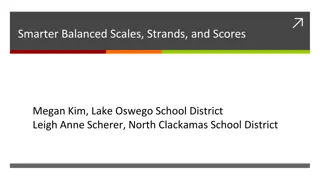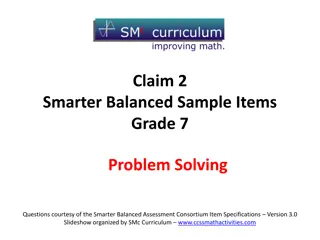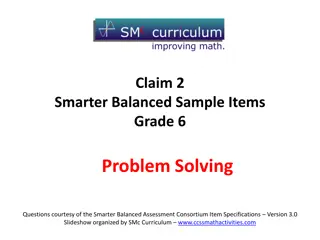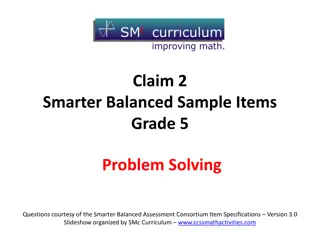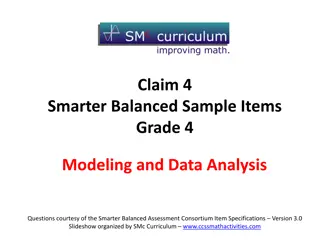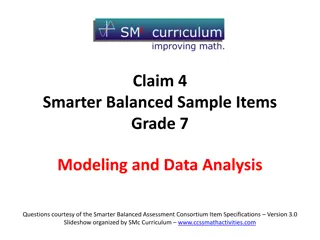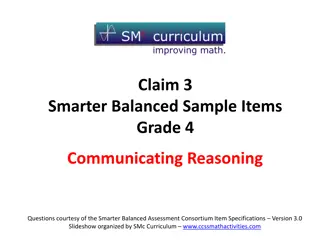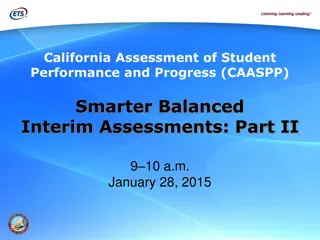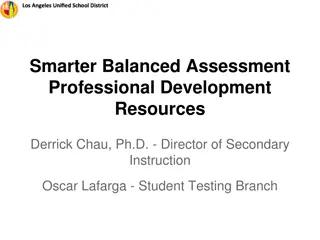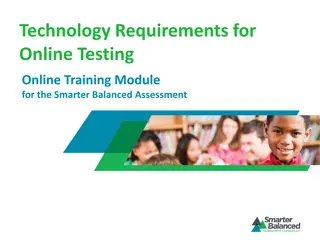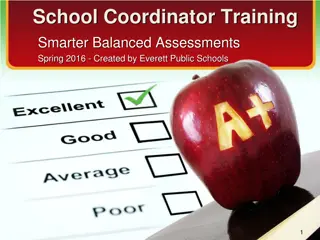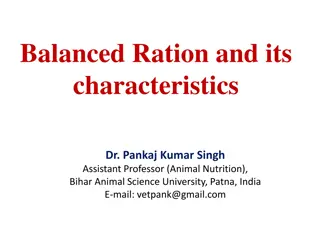Smarter Balanced High School Modeling & Data Analysis Questions
Explore sample modeling and data analysis questions from Smarter Balanced Assessment Consortium for high school students. Estimate water capacities of cisterns and lakes, adjust exponential models, and analyze literacy rates based on income per person in various countries. Enhance your understanding of real-world applications of mathematical concepts.
Download Presentation

Please find below an Image/Link to download the presentation.
The content on the website is provided AS IS for your information and personal use only. It may not be sold, licensed, or shared on other websites without obtaining consent from the author. Download presentation by click this link. If you encounter any issues during the download, it is possible that the publisher has removed the file from their server.
E N D
Presentation Transcript
High School Claim 4 Smarter Balanced Sample Items Modeling and Data Analysis Questions courtesy of the Smarter Balanced Assessment Consortium Item Specifications Version 3.0 Slideshow organized by SMc Curriculum www.ccssmathactivities.com
#1 A rainwater cistern is shown in the figure. Estimate that number of liters (l) of water the cistern can hold when full. Enter your estimate in the response box.
#1 Answer Rubric: (1 point) The student enters a reasonable estimate for the amount of water in the cistern. Answer: between 340 and 700
#2 Bear Lake straddles the border between Idaho and Utah. It is about 30 kilometers (km) long and about 11 km wide at the widest spot, as shown in the figure. The water is about 60 meters (m) deep at the deepest Spot with an average depth of about 30 m. Use this Information to estimate the number of liters (l) of Water in Bear Lake. Part A: Enter your estimate in the response box using scientific notation. Part B: The surface area of Bear Lake is approximately 280 km2. Use this information to improve your estimate of the number of liters contained in the lake if you can. Enter your revised estimate in the response box using scientific notation.
#2 Answer Rubric: (2 points) The student enters a reasonable estimate in Part A for the number of liters in the lake in the first response box and enters a more precise estimate for Part B that is closer to 8.4 x 1012. (1 point) The student enters a reasonable estimate for Part A but does not enter an improved estimate in the second box or the student enters an unreasonable estimate in the first response box and 8.4 x 1012 in the second response box. Answer: first response box: any number between 4.95 x 1012 and 9.9 x 1012
#3 This scatterplot shows the income per person (in U.S. dollars) versus the adult literacy rates for 30 countries throughout the world. The adult literacy rate is the percentage of people ages 15 and above who can, with understanding, read and write a short, simple statement about their everyday life. Part A: Use the slider to adjust the value for the base for the given exponential model so that it fits the data in the scatterplot. Part B: Your model predicts the literacy rates in some countries better than others. Which country s literacy rate is least well predicted by your model? Click on the point in the scatterplot to indicate your choice.
#3 Answer Rubric: (1 point) The student adjusts the graph so it fits the scatterplot reasonably well (see exemplar below). At a minimum, at least five of the data points must be above the graph and at least five must be below the graph. The student then clicks on the point that has the greatest vertical distance from their graph. Answer:
#4 Two airlines each made 30 flights. The dot plots shown compare how many minutes the actual arrival times were before or after the scheduled arrival times of these flights. Negative numbers represent the minutes the flight arrived before its scheduled time. Positive numbers represent the minutes the flight arrived after its scheduled time. Zero indicates the flight arrived at its scheduled time. Assuming you want to arrive as close to the scheduled time as possible, from which airline should you buy your ticket? Use all three drop-down menus to respond to this question. I should choose (Airline P/Airline Q) because the distribution of flights for Airline P has a center that is (greater than/about the same as/less than) the center of the distribution of flights for Airline P has a spread that is (greater than/about the same as/less than) the spread of the distribution for Airline Q.
#4 Answer Rubric: (2 points) The student choose Airline P, about the same as, less than. (1 point) The student chooses Airline P and one of the correct choices for the other two menus.
#5 Dirk wants to compare the performance of the school basketball team las year with its performance this year. Decide whether he will use the mean or the median number of points earned in a basketball game to make the comparison. Either measure is acceptable, but you must choose one. Dirk will use the (mean, median) number of points scored in a game. Based on the measure of center Dirk will use, which of the following is the best comparison between the performance of the school basketball team last season and this season? You can choose to view the data sets on which the histograms are based if you think it will help you choose. The basketball team performed (better, about the same, worse) this year than last year based on the fact that the (mean, median) is (higher, about the same, lower) this year.
#5 Answer Rubric: (1 point) The student selects mean or median, and then selects the answer choice that is best given their selection. Answer: If mean is selected: better; higher If median is selected: about the same; about the same
#6 Between 1980 and 1995, there was a single surviving group of Florida panthers that ranged from 30 to 50 individuals in number. In 1995, two females from a closely related species were introduced into this population, and the number of Florida panthers increased to 87 by 2003. Part A: Would you model this data with a piece-wise linear function or an exponential function? Select one of these models. Either model is acceptable, but you must choose one. Part B: You chose to model this data with a (piece-wise linear; exponential). This graph shows such a model. What would the approximate population of Florida panthers have been in 2005 according to the model you chose? Enter your answer in the response box.
#6 Answer Rubric: (1 point) The student selects a piece-wise linear or exponential, and then enters the appropriate estimate. Answer: If piece-wise linear is selected: between 98 and 100 If exponential is selected: between 240 and 260
#7 Eric is using a shovel to clear the snow from his driveway. He moves 8 shovelfuls of snow each minute. After 60 minutes of hard work, Eric states, I think I have shoveled more than a ton of snow. Part A: Estimate the weight of snow that Eric can move with each shovelful. If you want to, you can use the table of weights of everyday objects below. A ton is 2000 pounds, and a pound is 16 ounces. Eric can move (1 ounce/1 pound/10 pounds/0.25 tons) of snow with each shovelful. Part B:Use your estimate to decide if Eric s claim is correct or not.
#7 Answer Rubric: (1 point) The student selects 1 or 10 pounds and then the corresponding answer to part B. Answer: If 1 pound is selected: Eric is not correct. If 10 pounds is selected: Eric is correct.
#8 There is a traffic jam on a highway. A reporter is trying to estimate the number of vehicles involved in the traffic jam. Select all of the information that will help the reporter make a reasonable estimate of the number of vehicles in the traffic jam. A. The cause of the traffic jam B. The average length of a vehicle C. The number of lanes on the highway D. The average distance between vehicles E. The average number of people in each vehicle F. The distance from the beginning to the end of the traffic jam
#8 Answer Rubric: (1 point) Student selects the correct option(s). Answer: B, C, D, F
#9 Lisa was throwing a dart at a target. She threw 50 times with her left hand and 50 times with her right hand. The histograms show the distance Lisa missed the target by each time. Which statement is an appropriate inference based on the median of each data set? A. Lisa has better aim with her left hand because the median for her left hand is greater than the median for her right hand. B. Lisa has better aim with her right hand because the median for her left hand is less than the median for her right hand. C. Lisa has better aim with her left hand because the median for her left hand is less than the median for her right hand. D. Lisa has better aim with her right hand because the median for her left hand is greater than the median for her right hand.
#9 Answer Rubric: (1 point) The student selects the correct option. Answer: C
#10 The distributions of heights of 1000 men and 1000 women selected at random from the population of a large metropolitan area are shown. Which statement gives an accurate comparison of the heights of men and women shown? A. The mean height for women is greater than for men and women s heights vary more than men s heights. B. The mean height for women is greater than for men and women s heights vary less than men s heights. C. The mean height for women is less than for men and women s heights vary more than men s heights. D. The mean height for women is less than for men and women s heights vary less than men s heights.
#10 Answer Rubric: (1 point) Student selects the correct comparison statement. Answer: D
#11 Maia deposited $5500 in a bank account. The money earns interest annually, and the interest is deposited back into her account. Maia uses an online calculator to determine the amount of money she will have in the account at the end of each year. Follow these steps to use the calculator for each row in the table. Select number of years. Select Find Amount. The amount of money that Maia will have in her account at the end of the selected year, up to 12 years, will appear in the table. NOTE: Need interactive aspect to solve problem! You may use the calculator as many times as you need to help solve the problem. Enter an equation that models the amount of money, y, Maia will have in the account at the end of t years.
#11 Answer Rubric: (1 point) The student is able to determine an equation to fit the situation. Answer: y = 5500(1.03)t
#12 A researcher models the area of the surface of a pond using a rectangle, a semi-circle, and an isosceles triangle. Drag each shape onto the scale diagram of the pond to show how the model fits. Explain whether the researcher s model will estimate an area greater than, equal to, or less than the actual area of the pond s surface. Use specific examples and mathematics to support your answer.
#12 Answer Rubric: (2 points) The student is able to drag the shapes onto the pond in a way to model the best possible fit and make the determination that the pond is slightly larger than the combined areas of the three shapes. The student must supply an explanation that adjusts for the difference in size by either determining the areas of the shapes with specific values or stating how the pond is larger than the combined shapes by a certain portion of one of the shapes (e.g., the triangle needed to be about 2 units longer). (1 point) The student is able to place the shapes onto the pond in a way to model the best possible fit, but is not able to draw a correct conclusion or support the conclusion. Answer: The area of the pond is slightly greater than the combined area of the three shapes. The semi-circle is the best fit, with a only small amount of the pond extending out the right side, but that is accounted for because of the gap between the pond and the semi-circle at the bottom left side. The rectangle is a good match to the main portion of the pond. However, the triangle is smaller than the remaining portion of the pond. Given the combined area of the three shapes is about 39.3 + 105 +24.5 or 168.8 sq units, I would estimate the pond to be about 175 sq units.
#13 Lana wrote an article for the school newspaper about the seniors at her school. There are over 1000 students in the senior class and over 4000 students at her school. Lana asked all 40 of the seniors on the swim team whether they intend to go to college, and 22 said yes. She reported in her article that 55% of this year s senior class intends to go to college. How could Lana improve the accuracy of the information she reported in her article about the seniors at her school? Select all that apply. A. She could report that this only applies to seniors who are swimmers. B. She could check her arithmetic because she made a mistake computing the percentage. C. She could ask the guidance counselors what percentage of the senior class went to college last year. D. There is no need to improve the accuracy of the information she reported because she did everything correctly. E. She could randomly select 40 students at the all-senior assembly and ask them whether they intend to go to college.
#13 Answer Rubric: (1 point) The student selects all correct answer choices. Answer: A and E
#14 The relationship between Jack s distance from home and the time since he left home is linear, as show in the table. Based on the values in the table, determine whether each statement is true. Select True or False for each statement.
#14 Answer Rubric: (1 point) The student determines each statement as being either true or false. Answer: T, T, F
#15 The scatterplot shown represents the winning times for the women s 100 meter freestyle race for the Olympic Games between 1912 and 2012. Part A: Let x be the year since 1912 and f(x) be the winning time in seconds. Enter either a linear or an exponential function that models the data in the response box. Part B: Greta Andersen from Denmark won the race in 1948 with a time of 66.3 seconds. What is the difference between your model s prediction and Greta s actual winning time? Enter your answer in the response box. Part C: What does your model predict the winning time will be in the 2016 Olympics? Enter your answer in the response box.
#15 Answer Rubric: (2 points) The student enters an expression for f(x) in the first response box such that ? 0 82 10 and 53 10. The student the enters (? 36 66.3) within a reasonable tolerance in the second response box and enters ?(104) in the third response box. (1 point) The students enters an expression for ?(?) in the first response box such that ? 0 82 10 and ? 100 53 10, or, the student enters and expression that does not meet these criteria but successfully enters either (? 36 66.3) within a reasonable tolerance in the second response box or enters ?(104) in the third response box. ? 100



